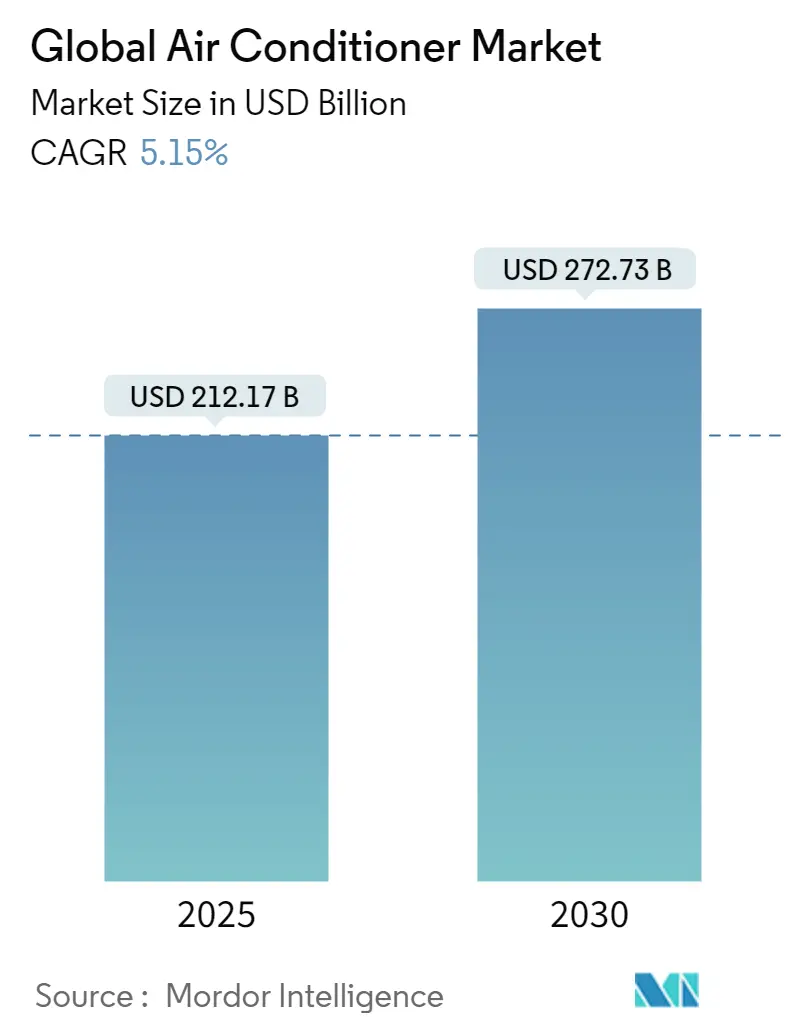
Mordor Intelligence has published a new report on the Global Air Conditioner Market, offering a comprehensive analysis of trends, growth drivers, and future projections.
The Global Air Conditioner Market is poised for significant growth, projected to expand from USD 212.17 billion in 2025 to USD 272.73 billion by 2030, reflecting a compound annual growth rate (CAGR) of 5.15% during the forecast period (2025-2030). This growth is fueled by rising global temperatures, increasing urbanization, and a growing emphasis on energy-efficient and smart cooling solutions.
Key Trends: Energy Efficiency and Smart Technologies Lead the Way
Emphasis on Energy Efficiency
With heightened awareness of environmental concerns and stringent energy regulations, there is a significant shift towards energy-efficient air conditioning systems. Governments worldwide are implementing minimum energy performance standards (MEPS), encouraging manufacturers to develop units that consume less power while delivering optimal performance.
Integration of Smart Technologies
The integration of Internet of Things (IoT) and smart technologies into air conditioning systems is transforming the market. Consumers now prefer units that offer remote control, energy consumption monitoring, and adaptive cooling based on occupancy and usage patterns. These smart features not only enhance user convenience but also contribute to energy savings.
Growth in Emerging Markets
Emerging economies, particularly in the Asia-Pacific region, are witnessing rapid urbanization and rising disposable incomes, leading to increased adoption of air conditioning systems. The region is expected to maintain its position as the largest market, driven by demand from both residential and commercial sectors.
Market Segmentation: Diverse Applications Across Sectors
The air conditioner market is segmented based on type, application, and geography.
By Type:
-
Split Systems: Dominant in residential applications due to their efficiency and ease of installation.
-
Window Units: Popular in smaller spaces and cost-sensitive markets.
-
Portable Units: Gaining traction for their mobility and convenience, especially in rental accommodations.
-
Central Systems: Preferred in large commercial and industrial settings for comprehensive climate control.
By Application:
-
Residential: Driven by increasing urban housing developments and the need for personal comfort.
-
Commercial: Includes offices, retail spaces, and hospitality sectors requiring consistent cooling solutions.
By Geography:
-
Asia-Pacific: Leading the market with high demand from countries like China and India.
-
North America: Experiencing growth due to technological advancements and replacement of older systems.
-
Europe: Focusing on energy-efficient and environmentally friendly systems.
-
Middle East & Africa: Demand driven by extreme temperatures and infrastructural developments.
-
South America: Emerging market with potential growth in residential and commercial sectors.
Explore Our Full Library of Home Property Improvement Research Industry Reports:
https://www.mordorintelligence.com/market-analysis/home-property-improvement
Key Players: Innovating for a Cooler Tomorrow
The air conditioner market features several key players who are at the forefront of innovation and market expansion:
-
Haier Group: Known for its diverse product range and focus on smart home solutions.
-
Daikin Industries: A leader in energy-efficient technologies and sustainable practices.
-
LG Electronics: Offers advanced air conditioning systems with smart connectivity features.
-
Samsung Electronics: Integrates cutting-edge technology to enhance user experience and energy savings.
-
Panasonic Corporation: Emphasizes eco-friendly solutions and innovative designs.
These companies are investing in research and development to introduce products that meet evolving consumer demands and regulatory standards.
Conclusion: A Future Focused on Sustainable Comfort
The global air conditioner market is on a trajectory of steady growth, propelled by technological advancements, environmental considerations, and increasing demand across various sectors. As the industry continues to evolve, the emphasis will remain on developing systems that offer superior performance, energy efficiency, and smart capabilities.
Industry Related Reports
Portable Air Conditioners Market: The portable air conditioners market report is segmented by product type, application, distribution channel, and geographic region. By Product Type: Includes single-hose portable air conditioners, double-hose portable air conditioners, and other types. By Application: Covers both residential and commercial uses. By Distribution Channel: Comprises direct sales, multi-brand outlets, specialty stores, and online platforms. By Geography: The market is analyzed across North America, Asia-Pacific, Europe, South America, the Middle East and Africa, and the rest of the world.
Air Conditioning Equipment Market: The air conditioning equipment market report categorizes the industry by type, end-user industry, and geographic region. By Type: The segments include split systems (both ducted and ductless), variable refrigerant flow (VRF) systems, air handling units, chillers, fan coils, indoor packaged and rooftop units, along with other types. By End-User Industry: The market is divided into residential, commercial, and industrial sectors. By Geography: The analysis covers North America, Asia, Australia and New Zealand, Europe, Latin America, and the Middle East and Africa.
UAE Portable Air Conditioning Market: The UAE portable air conditioning market report is segmented by product type, application, and distribution channel. By Product Type: Includes single-hose portable air conditioners, double-hose portable air conditioners, and other product types. By Application: Covers residential and commercial use. By Distribution Channel: Comprises direct sales, multi-brand outlets, specialty stores, and online platforms.
